Child Voice Implementation: Review of Protection Processes & Systems
VerifiedAdded on 2023/06/01
|12
|1957
|423
Report
AI Summary
This report examines the implementation of child voice within child protection processes and systems in Australia. It highlights the importance of advocacy services in ensuring children's rights and participation in decisions affecting their lives, referencing the UNCRC and Australian guidelines. The report discusses the findings of various research studies, Ofsted reports, and reviews, emphasizing the need for better advocacy services, improved national guidance, and therapeutic participation for children. It also explores the benefits of advocacy, such as increased accuracy of information and children feeling more involved in protection plans. The review concludes that while systems and policies are in place, there is limited systematic evidence on the effectiveness and reach of child advocacy programs, suggesting further research is needed. Desklib provides access to similar reports and solved assignments for students.
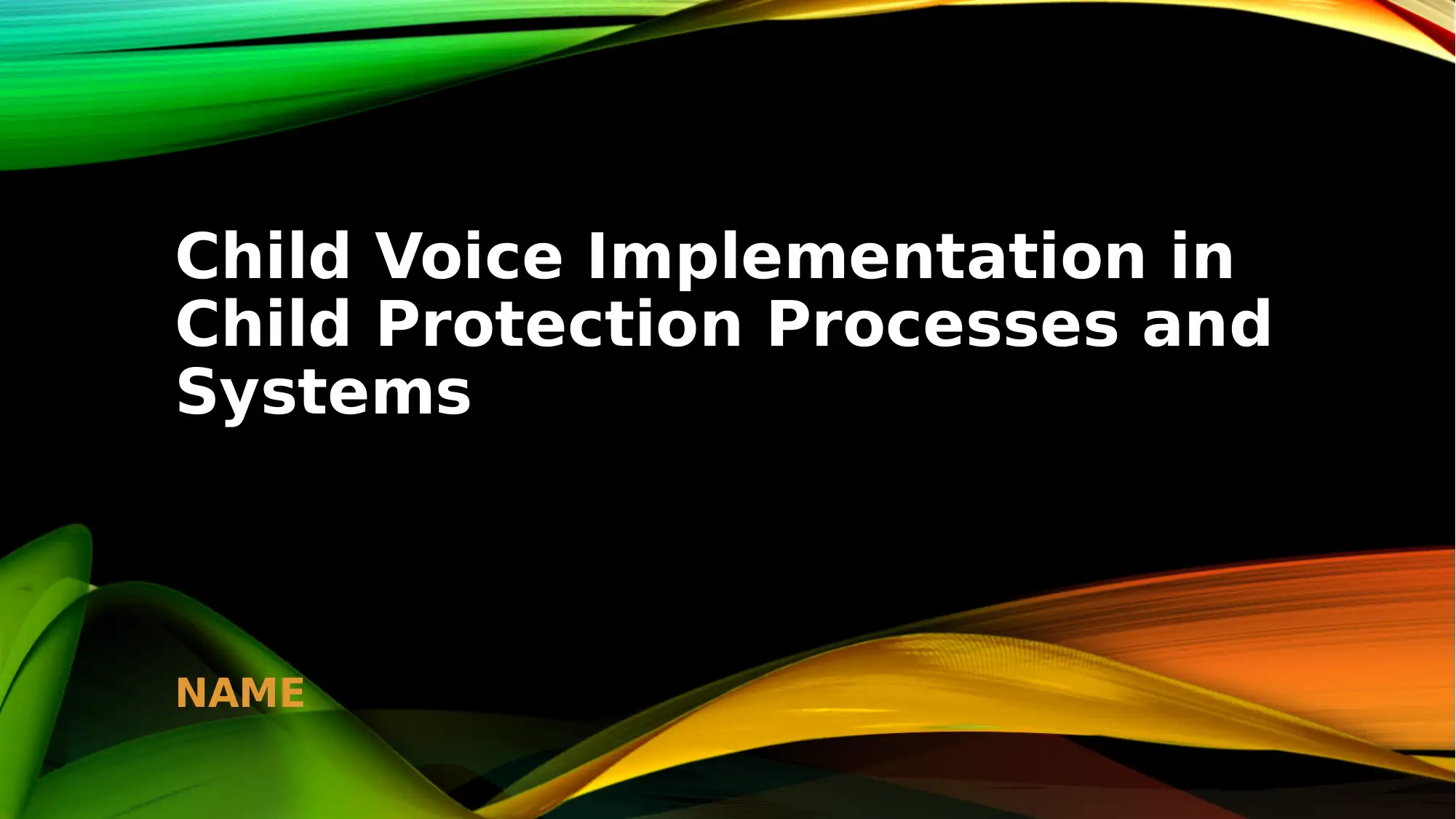
Child Voice Implementation in
Child Protection Processes and
Systems
NAME
Child Protection Processes and
Systems
NAME
Paraphrase This Document
Need a fresh take? Get an instant paraphrase of this document with our AI Paraphraser
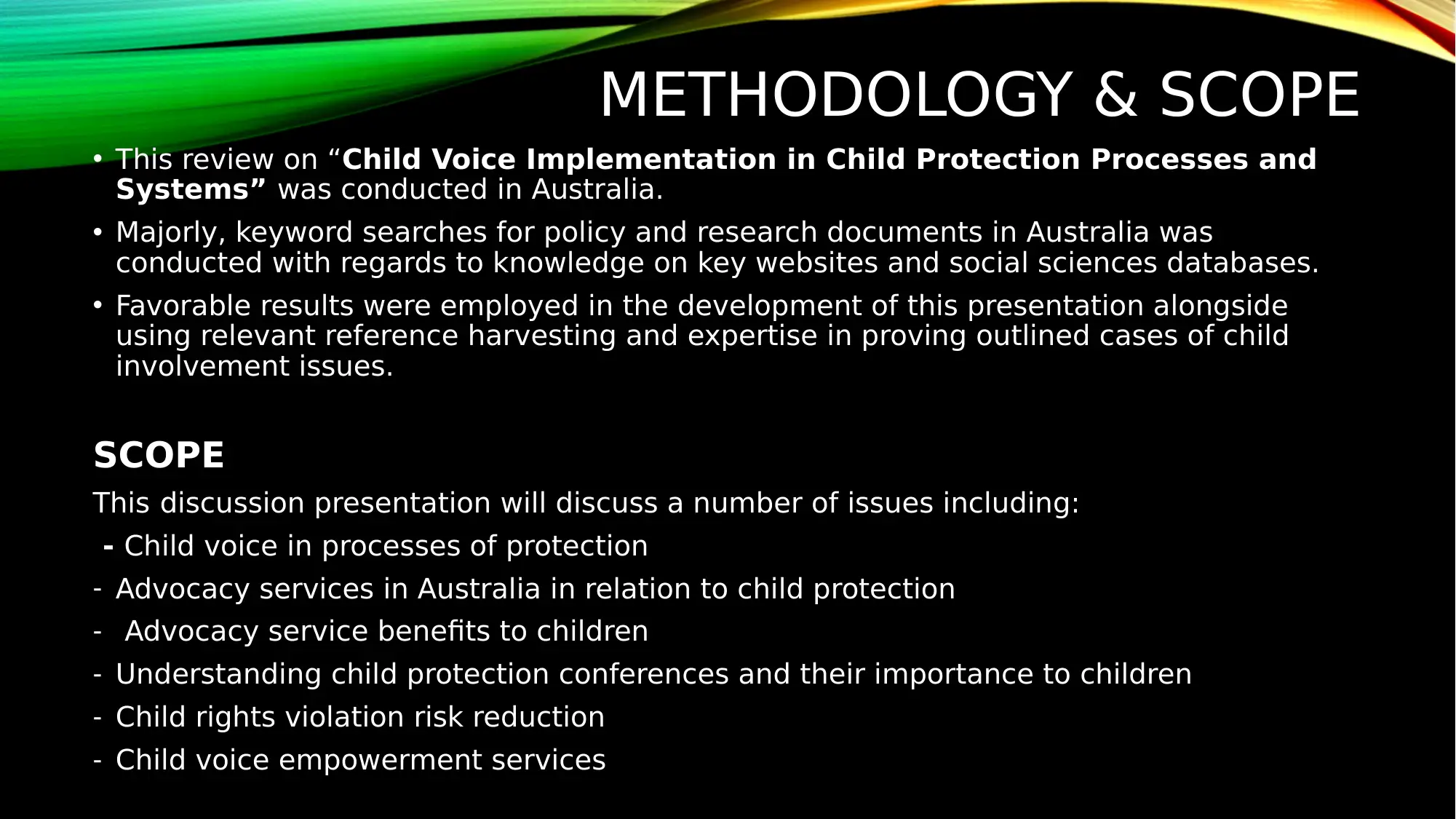
METHODOLOGY & SCOPE
• This review on “Child Voice Implementation in Child Protection Processes and
Systems” was conducted in Australia.
• Majorly, keyword searches for policy and research documents in Australia was
conducted with regards to knowledge on key websites and social sciences databases.
• Favorable results were employed in the development of this presentation alongside
using relevant reference harvesting and expertise in proving outlined cases of child
involvement issues.
SCOPE
This discussion presentation will discuss a number of issues including:
- Child voice in processes of protection
- Advocacy services in Australia in relation to child protection
- Advocacy service benefits to children
- Understanding child protection conferences and their importance to children
- Child rights violation risk reduction
- Child voice empowerment services
• This review on “Child Voice Implementation in Child Protection Processes and
Systems” was conducted in Australia.
• Majorly, keyword searches for policy and research documents in Australia was
conducted with regards to knowledge on key websites and social sciences databases.
• Favorable results were employed in the development of this presentation alongside
using relevant reference harvesting and expertise in proving outlined cases of child
involvement issues.
SCOPE
This discussion presentation will discuss a number of issues including:
- Child voice in processes of protection
- Advocacy services in Australia in relation to child protection
- Advocacy service benefits to children
- Understanding child protection conferences and their importance to children
- Child rights violation risk reduction
- Child voice empowerment services
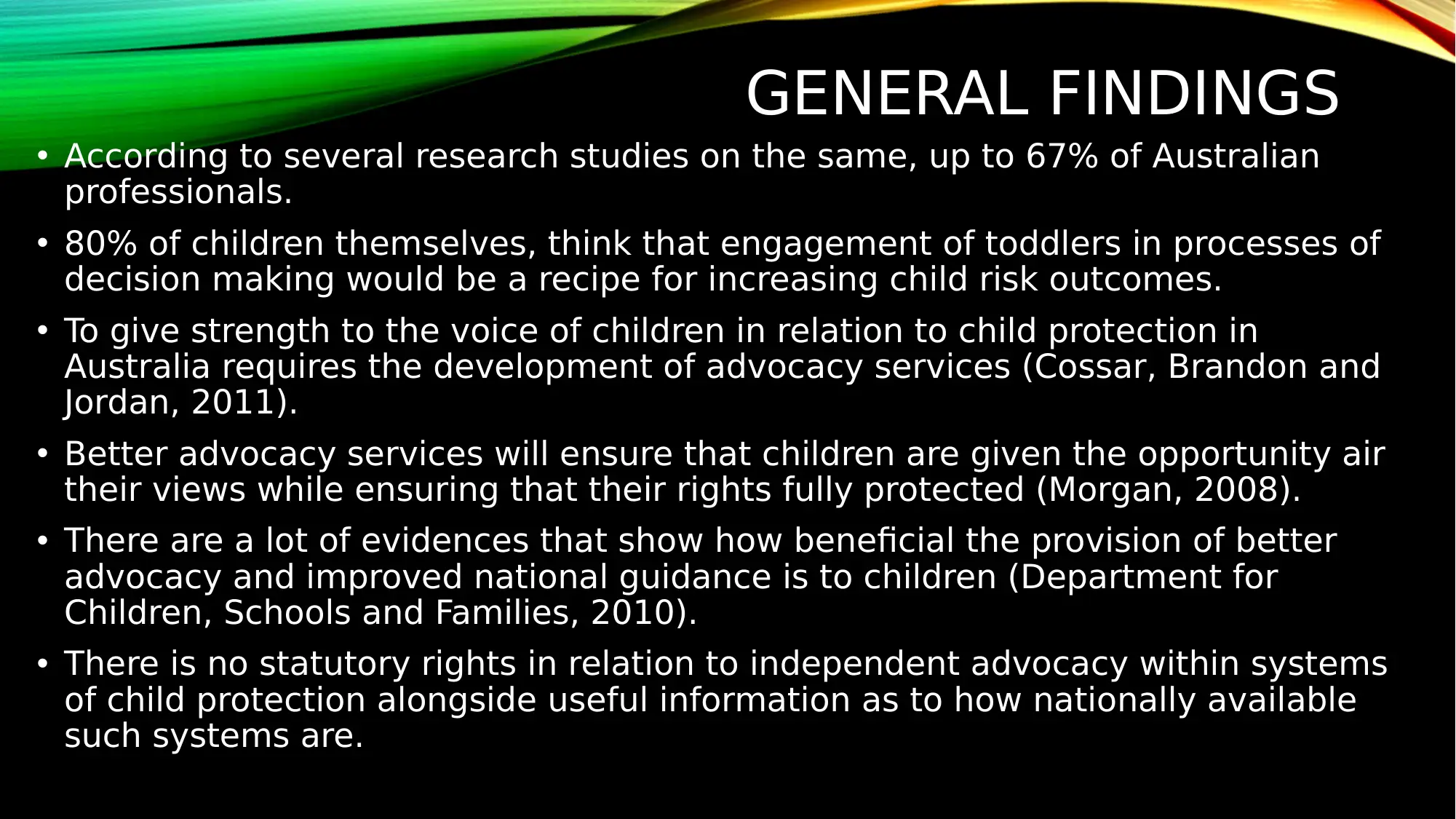
GENERAL FINDINGS
• According to several research studies on the same, up to 67% of Australian
professionals.
• 80% of children themselves, think that engagement of toddlers in processes of
decision making would be a recipe for increasing child risk outcomes.
• To give strength to the voice of children in relation to child protection in
Australia requires the development of advocacy services (Cossar, Brandon and
Jordan, 2011).
• Better advocacy services will ensure that children are given the opportunity air
their views while ensuring that their rights fully protected (Morgan, 2008).
• There are a lot of evidences that show how beneficial the provision of better
advocacy and improved national guidance is to children (Department for
Children, Schools and Families, 2010).
• There is no statutory rights in relation to independent advocacy within systems
of child protection alongside useful information as to how nationally available
such systems are.
• According to several research studies on the same, up to 67% of Australian
professionals.
• 80% of children themselves, think that engagement of toddlers in processes of
decision making would be a recipe for increasing child risk outcomes.
• To give strength to the voice of children in relation to child protection in
Australia requires the development of advocacy services (Cossar, Brandon and
Jordan, 2011).
• Better advocacy services will ensure that children are given the opportunity air
their views while ensuring that their rights fully protected (Morgan, 2008).
• There are a lot of evidences that show how beneficial the provision of better
advocacy and improved national guidance is to children (Department for
Children, Schools and Families, 2010).
• There is no statutory rights in relation to independent advocacy within systems
of child protection alongside useful information as to how nationally available
such systems are.
⊘ This is a preview!⊘
Do you want full access?
Subscribe today to unlock all pages.

Trusted by 1+ million students worldwide
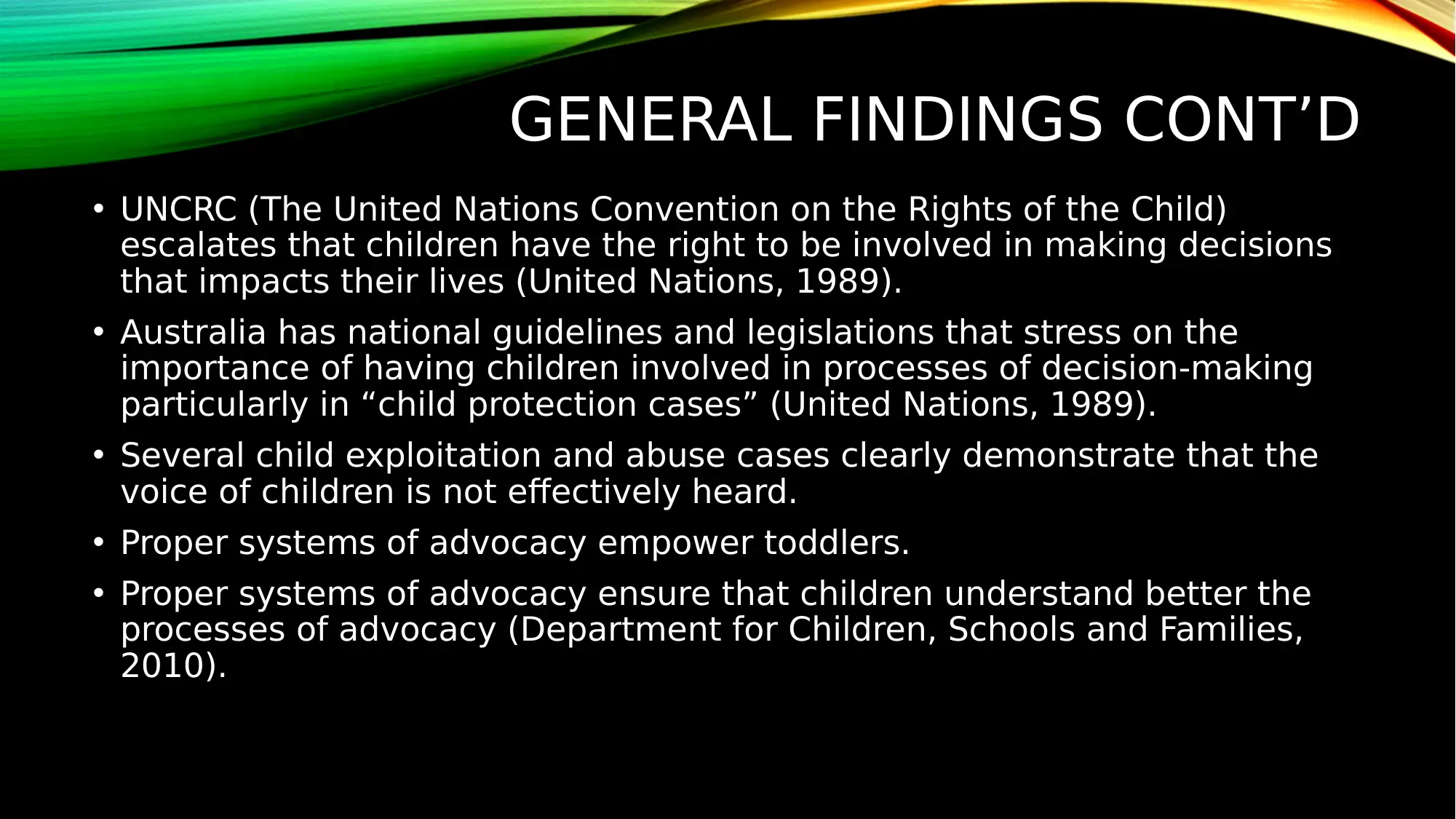
GENERAL FINDINGS CONT’D
• UNCRC (The United Nations Convention on the Rights of the Child)
escalates that children have the right to be involved in making decisions
that impacts their lives (United Nations, 1989).
• Australia has national guidelines and legislations that stress on the
importance of having children involved in processes of decision-making
particularly in “child protection cases” (United Nations, 1989).
• Several child exploitation and abuse cases clearly demonstrate that the
voice of children is not effectively heard.
• Proper systems of advocacy empower toddlers.
• Proper systems of advocacy ensure that children understand better the
processes of advocacy (Department for Children, Schools and Families,
2010).
• UNCRC (The United Nations Convention on the Rights of the Child)
escalates that children have the right to be involved in making decisions
that impacts their lives (United Nations, 1989).
• Australia has national guidelines and legislations that stress on the
importance of having children involved in processes of decision-making
particularly in “child protection cases” (United Nations, 1989).
• Several child exploitation and abuse cases clearly demonstrate that the
voice of children is not effectively heard.
• Proper systems of advocacy empower toddlers.
• Proper systems of advocacy ensure that children understand better the
processes of advocacy (Department for Children, Schools and Families,
2010).
Paraphrase This Document
Need a fresh take? Get an instant paraphrase of this document with our AI Paraphraser
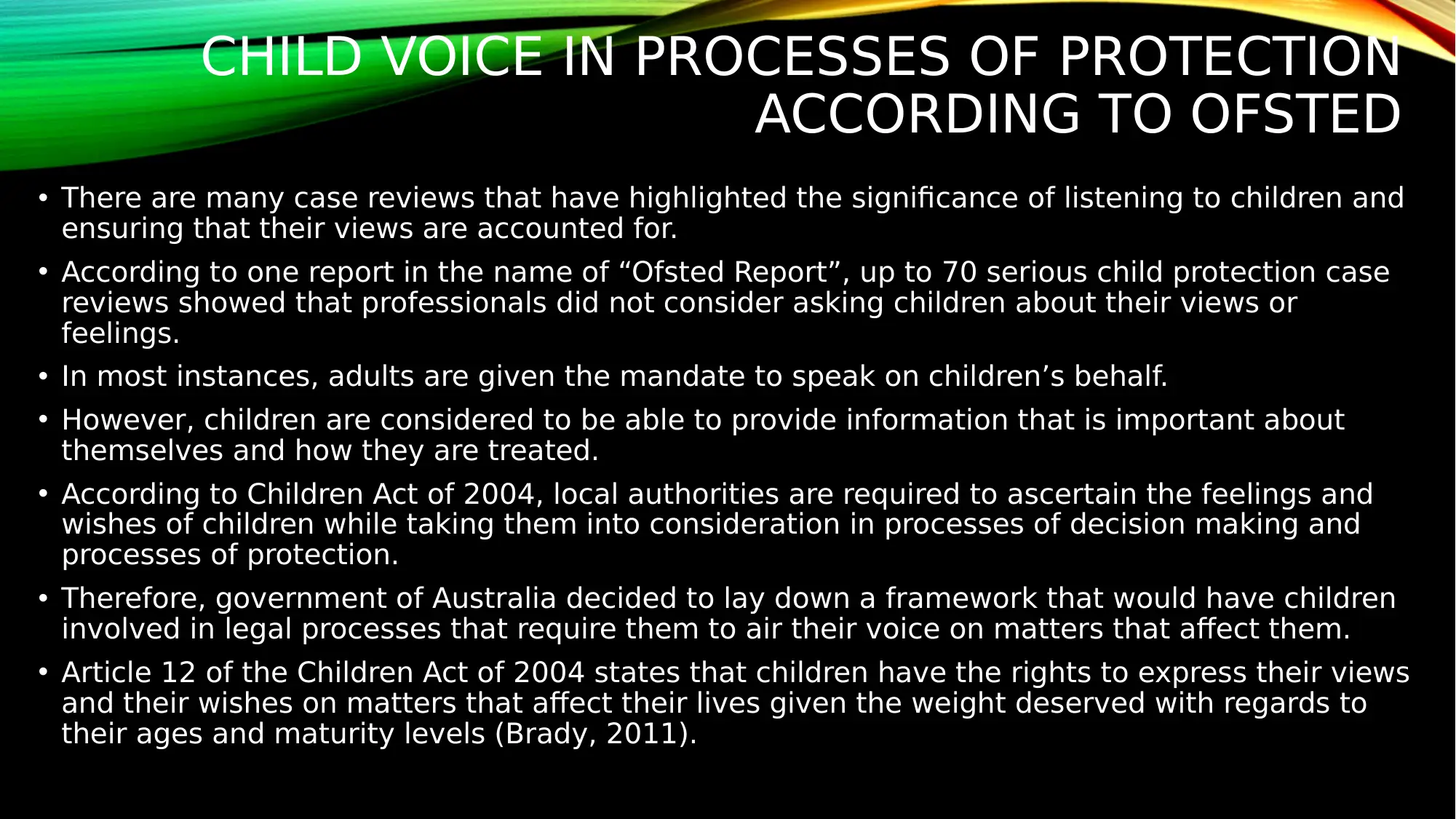
CHILD VOICE IN PROCESSES OF PROTECTION
ACCORDING TO OFSTED
• There are many case reviews that have highlighted the significance of listening to children and
ensuring that their views are accounted for.
• According to one report in the name of “Ofsted Report”, up to 70 serious child protection case
reviews showed that professionals did not consider asking children about their views or
feelings.
• In most instances, adults are given the mandate to speak on children’s behalf.
• However, children are considered to be able to provide information that is important about
themselves and how they are treated.
• According to Children Act of 2004, local authorities are required to ascertain the feelings and
wishes of children while taking them into consideration in processes of decision making and
processes of protection.
• Therefore, government of Australia decided to lay down a framework that would have children
involved in legal processes that require them to air their voice on matters that affect them.
• Article 12 of the Children Act of 2004 states that children have the rights to express their views
and their wishes on matters that affect their lives given the weight deserved with regards to
their ages and maturity levels (Brady, 2011).
ACCORDING TO OFSTED
• There are many case reviews that have highlighted the significance of listening to children and
ensuring that their views are accounted for.
• According to one report in the name of “Ofsted Report”, up to 70 serious child protection case
reviews showed that professionals did not consider asking children about their views or
feelings.
• In most instances, adults are given the mandate to speak on children’s behalf.
• However, children are considered to be able to provide information that is important about
themselves and how they are treated.
• According to Children Act of 2004, local authorities are required to ascertain the feelings and
wishes of children while taking them into consideration in processes of decision making and
processes of protection.
• Therefore, government of Australia decided to lay down a framework that would have children
involved in legal processes that require them to air their voice on matters that affect them.
• Article 12 of the Children Act of 2004 states that children have the rights to express their views
and their wishes on matters that affect their lives given the weight deserved with regards to
their ages and maturity levels (Brady, 2011).
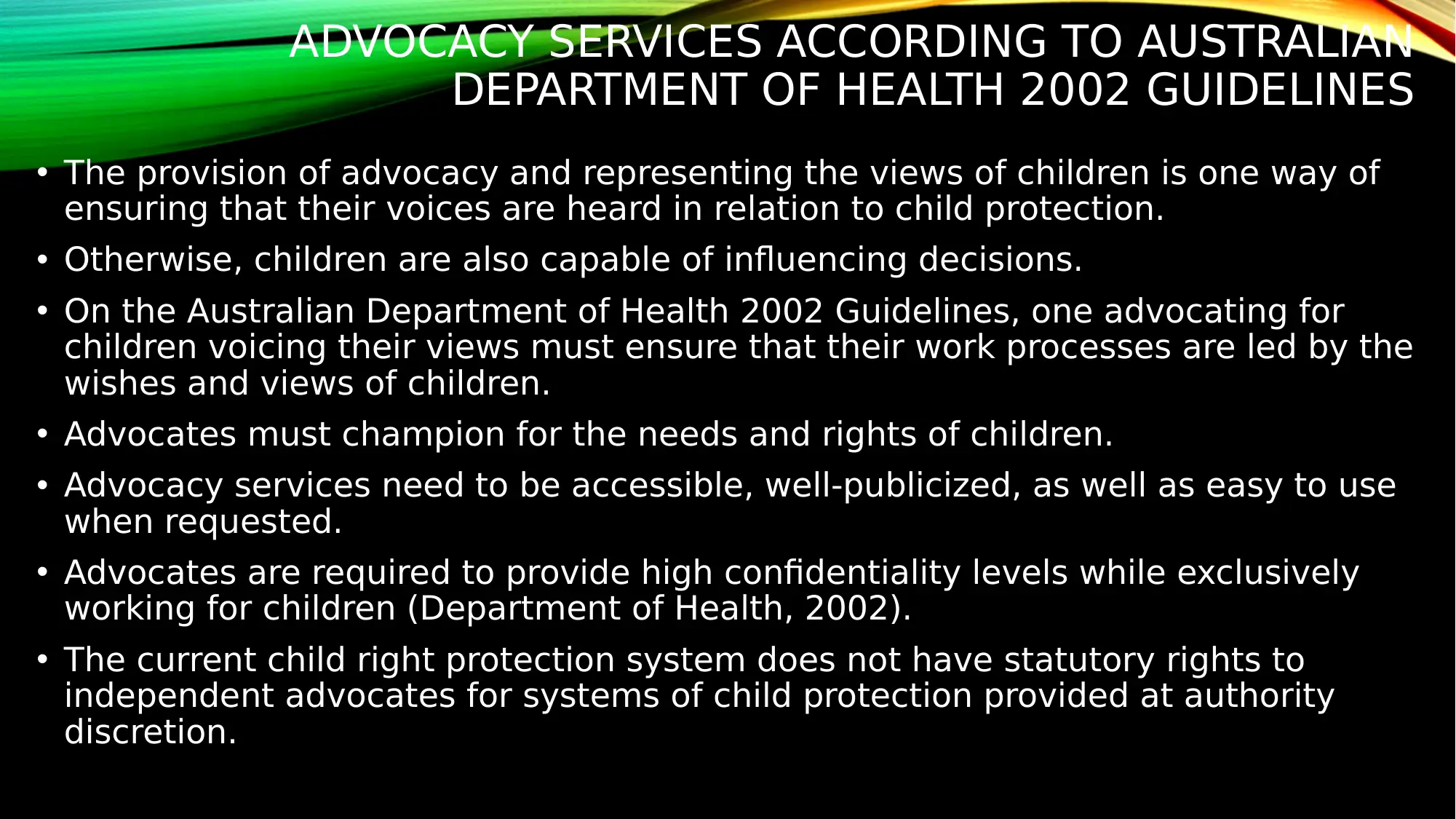
ADVOCACY SERVICES ACCORDING TO AUSTRALIAN
DEPARTMENT OF HEALTH 2002 GUIDELINES
• The provision of advocacy and representing the views of children is one way of
ensuring that their voices are heard in relation to child protection.
• Otherwise, children are also capable of influencing decisions.
• On the Australian Department of Health 2002 Guidelines, one advocating for
children voicing their views must ensure that their work processes are led by the
wishes and views of children.
• Advocates must champion for the needs and rights of children.
• Advocacy services need to be accessible, well-publicized, as well as easy to use
when requested.
• Advocates are required to provide high confidentiality levels while exclusively
working for children (Department of Health, 2002).
• The current child right protection system does not have statutory rights to
independent advocates for systems of child protection provided at authority
discretion.
DEPARTMENT OF HEALTH 2002 GUIDELINES
• The provision of advocacy and representing the views of children is one way of
ensuring that their voices are heard in relation to child protection.
• Otherwise, children are also capable of influencing decisions.
• On the Australian Department of Health 2002 Guidelines, one advocating for
children voicing their views must ensure that their work processes are led by the
wishes and views of children.
• Advocates must champion for the needs and rights of children.
• Advocacy services need to be accessible, well-publicized, as well as easy to use
when requested.
• Advocates are required to provide high confidentiality levels while exclusively
working for children (Department of Health, 2002).
• The current child right protection system does not have statutory rights to
independent advocates for systems of child protection provided at authority
discretion.
⊘ This is a preview!⊘
Do you want full access?
Subscribe today to unlock all pages.

Trusted by 1+ million students worldwide
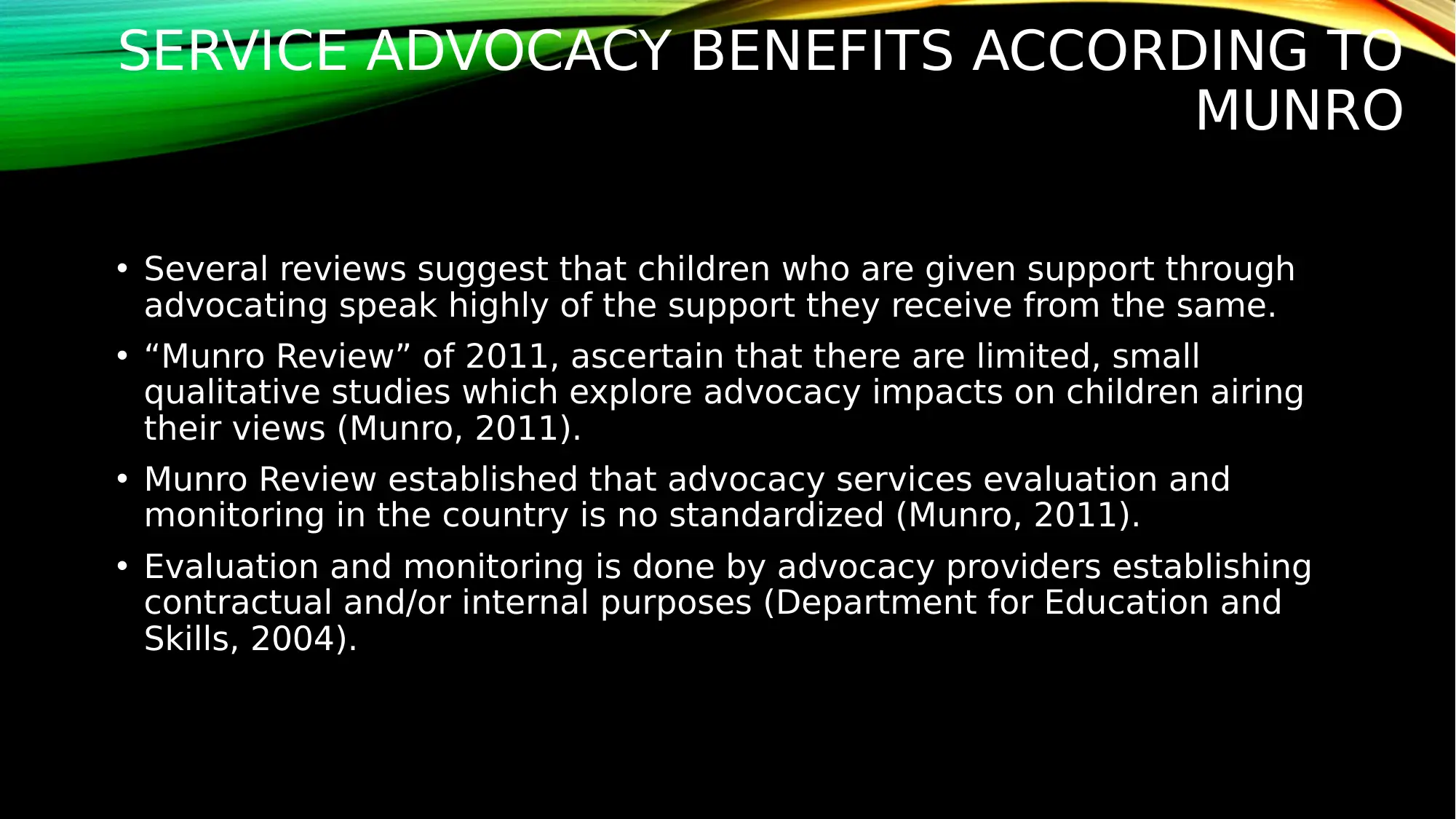
SERVICE ADVOCACY BENEFITS ACCORDING TO
MUNRO
• Several reviews suggest that children who are given support through
advocating speak highly of the support they receive from the same.
• “Munro Review” of 2011, ascertain that there are limited, small
qualitative studies which explore advocacy impacts on children airing
their views (Munro, 2011).
• Munro Review established that advocacy services evaluation and
monitoring in the country is no standardized (Munro, 2011).
• Evaluation and monitoring is done by advocacy providers establishing
contractual and/or internal purposes (Department for Education and
Skills, 2004).
MUNRO
• Several reviews suggest that children who are given support through
advocating speak highly of the support they receive from the same.
• “Munro Review” of 2011, ascertain that there are limited, small
qualitative studies which explore advocacy impacts on children airing
their views (Munro, 2011).
• Munro Review established that advocacy services evaluation and
monitoring in the country is no standardized (Munro, 2011).
• Evaluation and monitoring is done by advocacy providers establishing
contractual and/or internal purposes (Department for Education and
Skills, 2004).
Paraphrase This Document
Need a fresh take? Get an instant paraphrase of this document with our AI Paraphraser
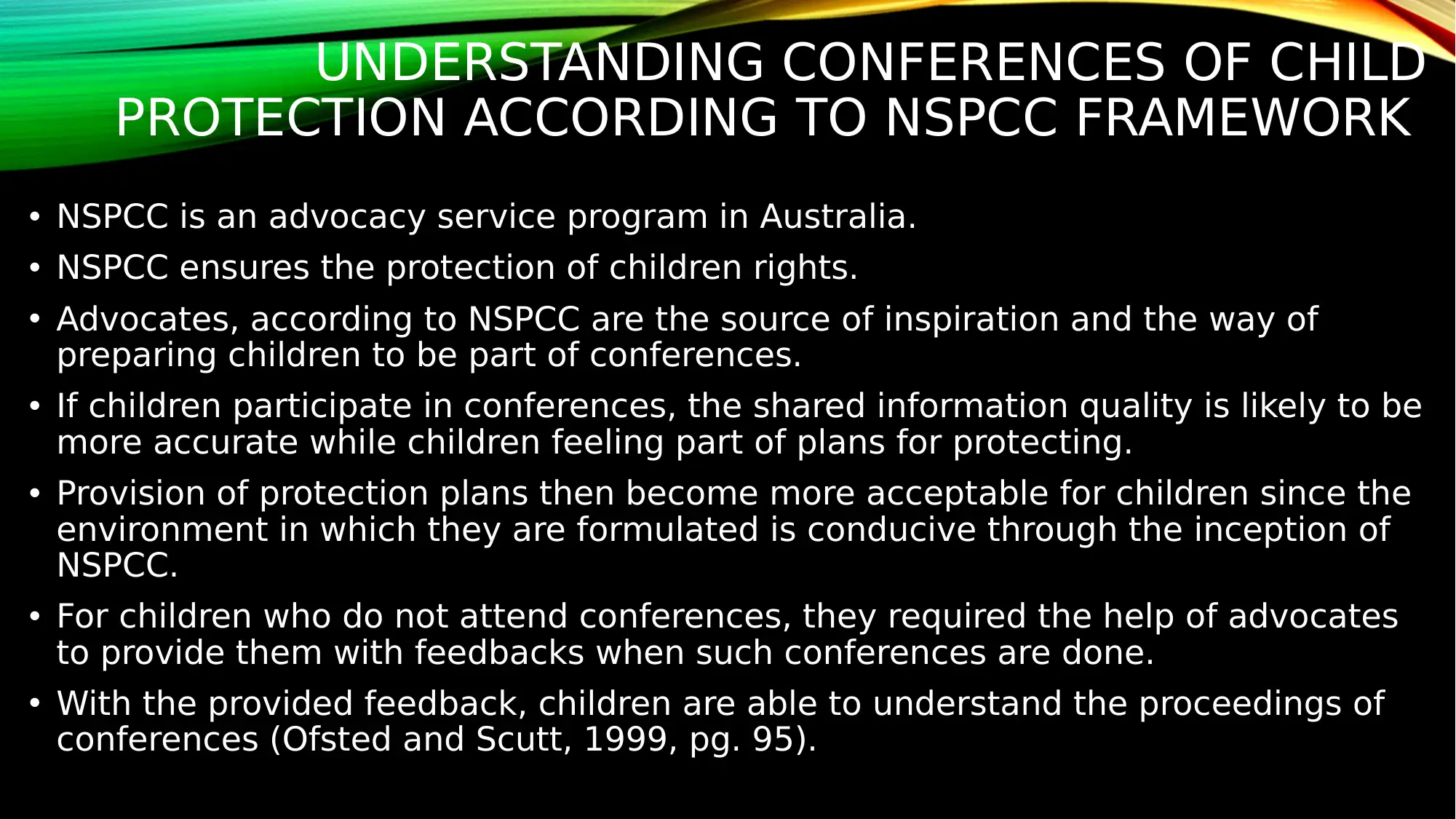
UNDERSTANDING CONFERENCES OF CHILD
PROTECTION ACCORDING TO NSPCC FRAMEWORK
• NSPCC is an advocacy service program in Australia.
• NSPCC ensures the protection of children rights.
• Advocates, according to NSPCC are the source of inspiration and the way of
preparing children to be part of conferences.
• If children participate in conferences, the shared information quality is likely to be
more accurate while children feeling part of plans for protecting.
• Provision of protection plans then become more acceptable for children since the
environment in which they are formulated is conducive through the inception of
NSPCC.
• For children who do not attend conferences, they required the help of advocates
to provide them with feedbacks when such conferences are done.
• With the provided feedback, children are able to understand the proceedings of
conferences (Ofsted and Scutt, 1999, pg. 95).
PROTECTION ACCORDING TO NSPCC FRAMEWORK
• NSPCC is an advocacy service program in Australia.
• NSPCC ensures the protection of children rights.
• Advocates, according to NSPCC are the source of inspiration and the way of
preparing children to be part of conferences.
• If children participate in conferences, the shared information quality is likely to be
more accurate while children feeling part of plans for protecting.
• Provision of protection plans then become more acceptable for children since the
environment in which they are formulated is conducive through the inception of
NSPCC.
• For children who do not attend conferences, they required the help of advocates
to provide them with feedbacks when such conferences are done.
• With the provided feedback, children are able to understand the proceedings of
conferences (Ofsted and Scutt, 1999, pg. 95).
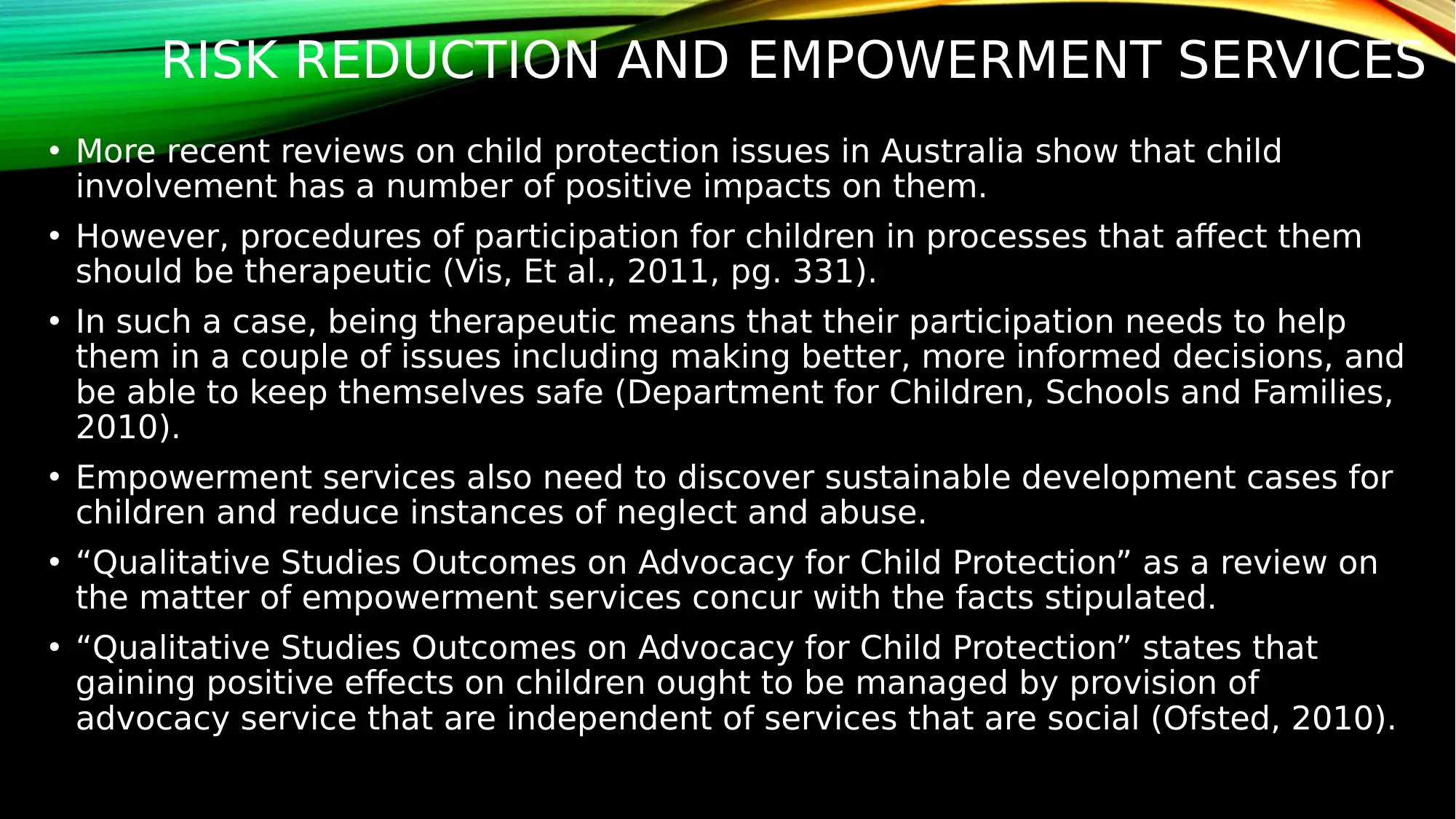
RISK REDUCTION AND EMPOWERMENT SERVICES
• More recent reviews on child protection issues in Australia show that child
involvement has a number of positive impacts on them.
• However, procedures of participation for children in processes that affect them
should be therapeutic (Vis, Et al., 2011, pg. 331).
• In such a case, being therapeutic means that their participation needs to help
them in a couple of issues including making better, more informed decisions, and
be able to keep themselves safe (Department for Children, Schools and Families,
2010).
• Empowerment services also need to discover sustainable development cases for
children and reduce instances of neglect and abuse.
• “Qualitative Studies Outcomes on Advocacy for Child Protection” as a review on
the matter of empowerment services concur with the facts stipulated.
• “Qualitative Studies Outcomes on Advocacy for Child Protection” states that
gaining positive effects on children ought to be managed by provision of
advocacy service that are independent of services that are social (Ofsted, 2010).
• More recent reviews on child protection issues in Australia show that child
involvement has a number of positive impacts on them.
• However, procedures of participation for children in processes that affect them
should be therapeutic (Vis, Et al., 2011, pg. 331).
• In such a case, being therapeutic means that their participation needs to help
them in a couple of issues including making better, more informed decisions, and
be able to keep themselves safe (Department for Children, Schools and Families,
2010).
• Empowerment services also need to discover sustainable development cases for
children and reduce instances of neglect and abuse.
• “Qualitative Studies Outcomes on Advocacy for Child Protection” as a review on
the matter of empowerment services concur with the facts stipulated.
• “Qualitative Studies Outcomes on Advocacy for Child Protection” states that
gaining positive effects on children ought to be managed by provision of
advocacy service that are independent of services that are social (Ofsted, 2010).
⊘ This is a preview!⊘
Do you want full access?
Subscribe today to unlock all pages.

Trusted by 1+ million students worldwide
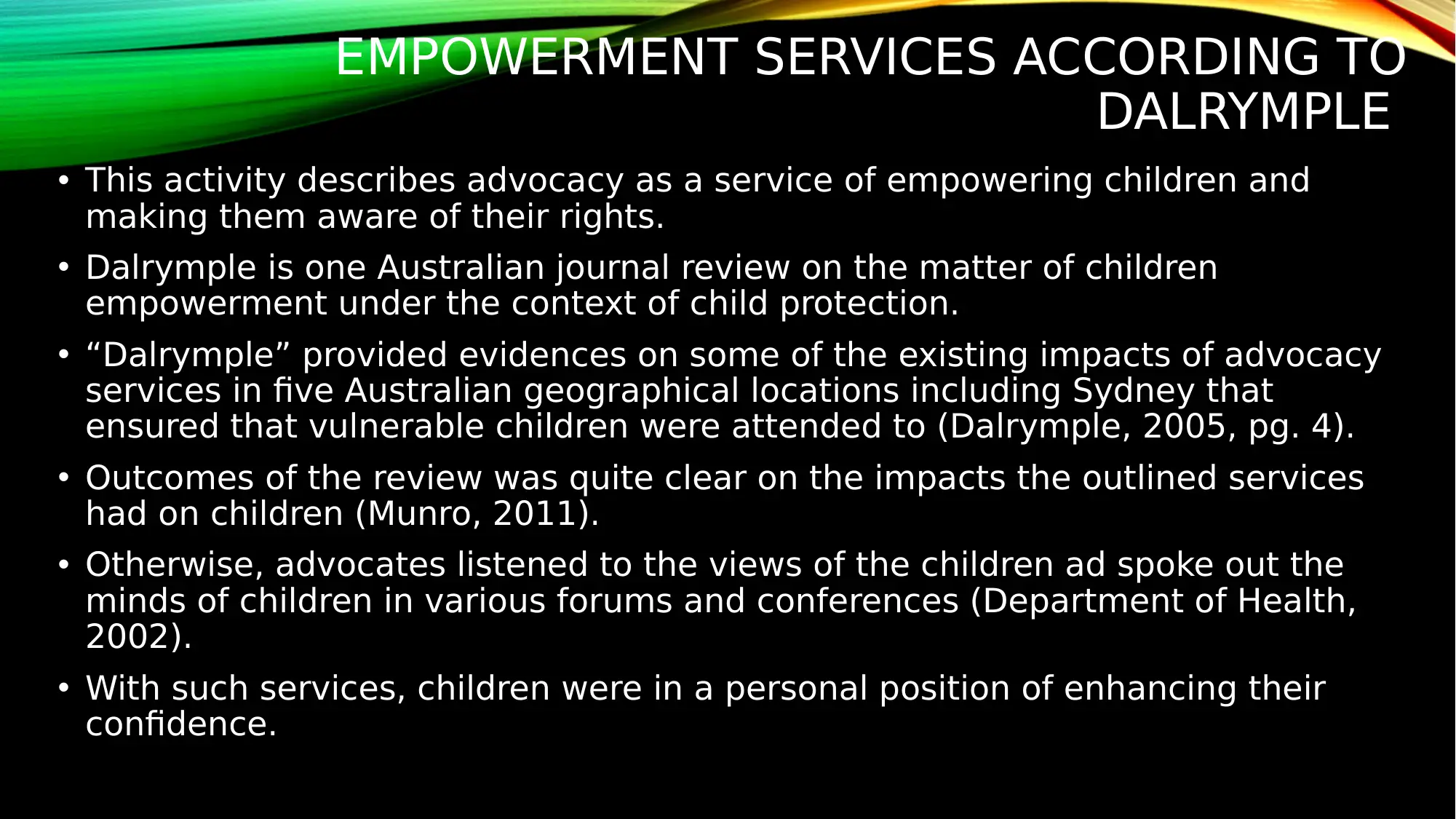
EMPOWERMENT SERVICES ACCORDING TO
DALRYMPLE
• This activity describes advocacy as a service of empowering children and
making them aware of their rights.
• Dalrymple is one Australian journal review on the matter of children
empowerment under the context of child protection.
• “Dalrymple” provided evidences on some of the existing impacts of advocacy
services in five Australian geographical locations including Sydney that
ensured that vulnerable children were attended to (Dalrymple, 2005, pg. 4).
• Outcomes of the review was quite clear on the impacts the outlined services
had on children (Munro, 2011).
• Otherwise, advocates listened to the views of the children ad spoke out the
minds of children in various forums and conferences (Department of Health,
2002).
• With such services, children were in a personal position of enhancing their
confidence.
DALRYMPLE
• This activity describes advocacy as a service of empowering children and
making them aware of their rights.
• Dalrymple is one Australian journal review on the matter of children
empowerment under the context of child protection.
• “Dalrymple” provided evidences on some of the existing impacts of advocacy
services in five Australian geographical locations including Sydney that
ensured that vulnerable children were attended to (Dalrymple, 2005, pg. 4).
• Outcomes of the review was quite clear on the impacts the outlined services
had on children (Munro, 2011).
• Otherwise, advocates listened to the views of the children ad spoke out the
minds of children in various forums and conferences (Department of Health,
2002).
• With such services, children were in a personal position of enhancing their
confidence.
Paraphrase This Document
Need a fresh take? Get an instant paraphrase of this document with our AI Paraphraser
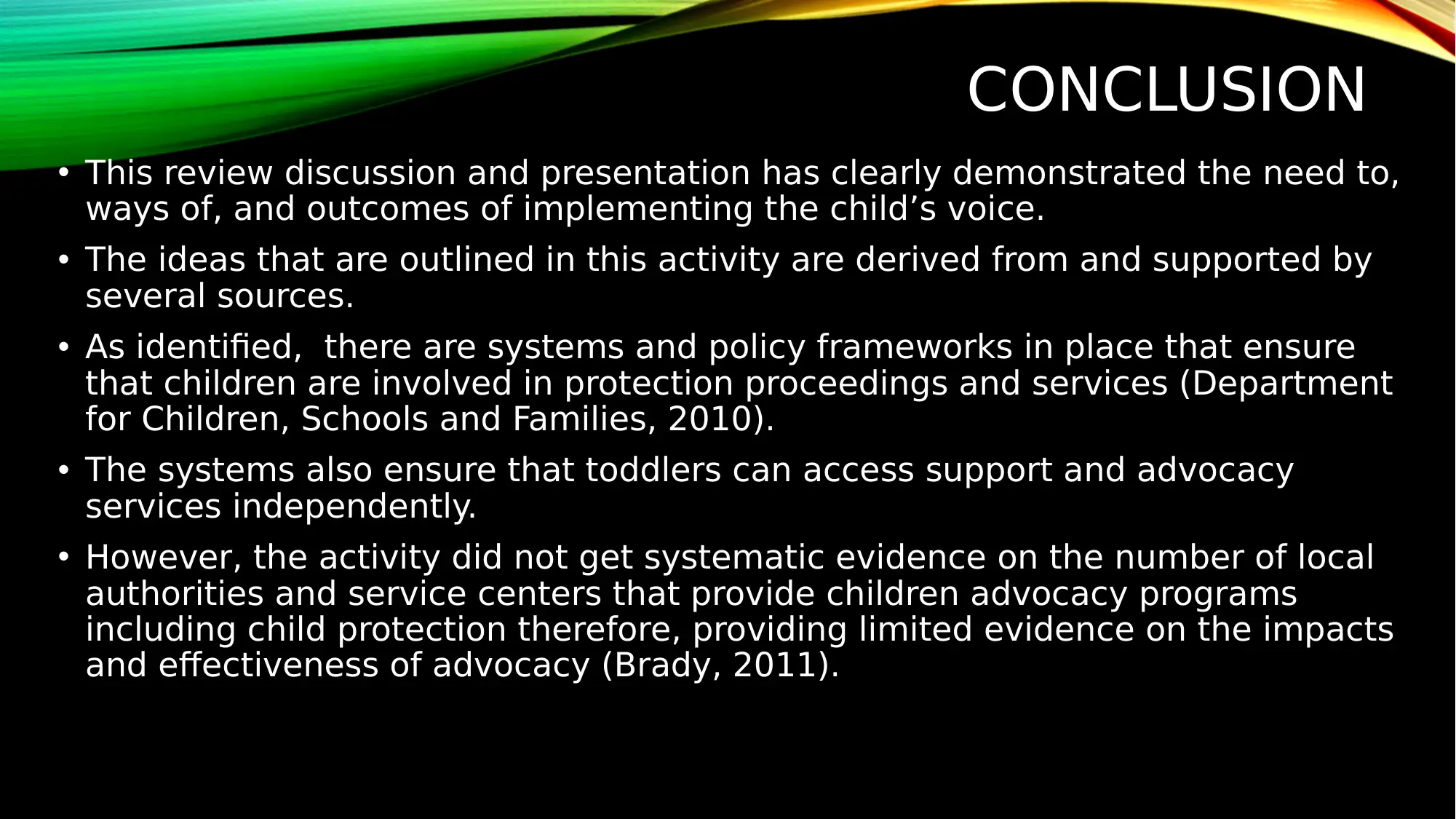
CONCLUSION
• This review discussion and presentation has clearly demonstrated the need to,
ways of, and outcomes of implementing the child’s voice.
• The ideas that are outlined in this activity are derived from and supported by
several sources.
• As identified, there are systems and policy frameworks in place that ensure
that children are involved in protection proceedings and services (Department
for Children, Schools and Families, 2010).
• The systems also ensure that toddlers can access support and advocacy
services independently.
• However, the activity did not get systematic evidence on the number of local
authorities and service centers that provide children advocacy programs
including child protection therefore, providing limited evidence on the impacts
and effectiveness of advocacy (Brady, 2011).
• This review discussion and presentation has clearly demonstrated the need to,
ways of, and outcomes of implementing the child’s voice.
• The ideas that are outlined in this activity are derived from and supported by
several sources.
• As identified, there are systems and policy frameworks in place that ensure
that children are involved in protection proceedings and services (Department
for Children, Schools and Families, 2010).
• The systems also ensure that toddlers can access support and advocacy
services independently.
• However, the activity did not get systematic evidence on the number of local
authorities and service centers that provide children advocacy programs
including child protection therefore, providing limited evidence on the impacts
and effectiveness of advocacy (Brady, 2011).
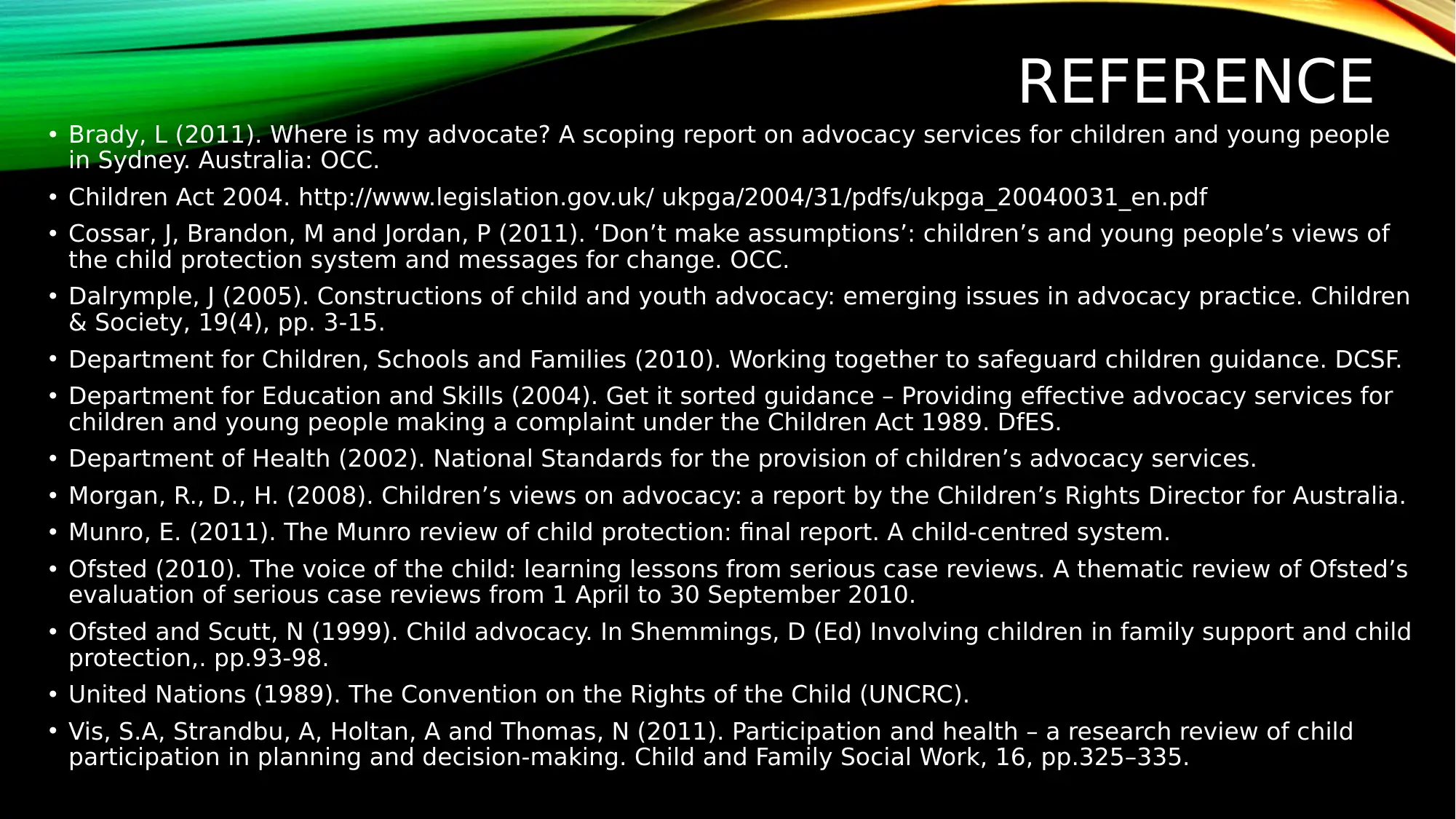
REFERENCE
• Brady, L (2011). Where is my advocate? A scoping report on advocacy services for children and young people
in Sydney. Australia: OCC.
• Children Act 2004. http://www.legislation.gov.uk/ ukpga/2004/31/pdfs/ukpga_20040031_en.pdf
• Cossar, J, Brandon, M and Jordan, P (2011). ‘Don’t make assumptions’: children’s and young people’s views of
the child protection system and messages for change. OCC.
• Dalrymple, J (2005). Constructions of child and youth advocacy: emerging issues in advocacy practice. Children
& Society, 19(4), pp. 3-15.
• Department for Children, Schools and Families (2010). Working together to safeguard children guidance. DCSF.
• Department for Education and Skills (2004). Get it sorted guidance – Providing effective advocacy services for
children and young people making a complaint under the Children Act 1989. DfES.
• Department of Health (2002). National Standards for the provision of children’s advocacy services.
• Morgan, R., D., H. (2008). Children’s views on advocacy: a report by the Children’s Rights Director for Australia.
• Munro, E. (2011). The Munro review of child protection: final report. A child-centred system.
• Ofsted (2010). The voice of the child: learning lessons from serious case reviews. A thematic review of Ofsted’s
evaluation of serious case reviews from 1 April to 30 September 2010.
• Ofsted and Scutt, N (1999). Child advocacy. In Shemmings, D (Ed) Involving children in family support and child
protection,. pp.93-98.
• United Nations (1989). The Convention on the Rights of the Child (UNCRC).
• Vis, S.A, Strandbu, A, Holtan, A and Thomas, N (2011). Participation and health – a research review of child
participation in planning and decision-making. Child and Family Social Work, 16, pp.325–335.
• Brady, L (2011). Where is my advocate? A scoping report on advocacy services for children and young people
in Sydney. Australia: OCC.
• Children Act 2004. http://www.legislation.gov.uk/ ukpga/2004/31/pdfs/ukpga_20040031_en.pdf
• Cossar, J, Brandon, M and Jordan, P (2011). ‘Don’t make assumptions’: children’s and young people’s views of
the child protection system and messages for change. OCC.
• Dalrymple, J (2005). Constructions of child and youth advocacy: emerging issues in advocacy practice. Children
& Society, 19(4), pp. 3-15.
• Department for Children, Schools and Families (2010). Working together to safeguard children guidance. DCSF.
• Department for Education and Skills (2004). Get it sorted guidance – Providing effective advocacy services for
children and young people making a complaint under the Children Act 1989. DfES.
• Department of Health (2002). National Standards for the provision of children’s advocacy services.
• Morgan, R., D., H. (2008). Children’s views on advocacy: a report by the Children’s Rights Director for Australia.
• Munro, E. (2011). The Munro review of child protection: final report. A child-centred system.
• Ofsted (2010). The voice of the child: learning lessons from serious case reviews. A thematic review of Ofsted’s
evaluation of serious case reviews from 1 April to 30 September 2010.
• Ofsted and Scutt, N (1999). Child advocacy. In Shemmings, D (Ed) Involving children in family support and child
protection,. pp.93-98.
• United Nations (1989). The Convention on the Rights of the Child (UNCRC).
• Vis, S.A, Strandbu, A, Holtan, A and Thomas, N (2011). Participation and health – a research review of child
participation in planning and decision-making. Child and Family Social Work, 16, pp.325–335.
⊘ This is a preview!⊘
Do you want full access?
Subscribe today to unlock all pages.

Trusted by 1+ million students worldwide
1 out of 12
Related Documents
Your All-in-One AI-Powered Toolkit for Academic Success.
+13062052269
info@desklib.com
Available 24*7 on WhatsApp / Email
![[object Object]](/_next/static/media/star-bottom.7253800d.svg)
Unlock your academic potential
Copyright © 2020–2025 A2Z Services. All Rights Reserved. Developed and managed by ZUCOL.




